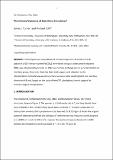Files in this item
The infrared dynamics of iron diene complexes
Item metadata
| dc.contributor.author | Turner, James | |
| dc.contributor.author | Buehl, Michael | |
| dc.date.accessioned | 2019-02-02T00:33:48Z | |
| dc.date.available | 2019-02-02T00:33:48Z | |
| dc.date.issued | 2018-04-12 | |
| dc.identifier | 252203147 | |
| dc.identifier | e34b8dee-8b9b-404c-ad3a-272120b181cd | |
| dc.identifier | 85045392959 | |
| dc.identifier | 000430255600001 | |
| dc.identifier.citation | Turner , J & Buehl , M 2018 , ' The infrared dynamics of iron diene complexes ' , Journal of Physical Chemistry A , vol. 122 , no. 14 , pp. 3497-3505 . https://doi.org/10.1021/acs.jpca.7b12309 | en |
| dc.identifier.issn | 1089-5639 | |
| dc.identifier.uri | https://hdl.handle.net/10023/16989 | |
| dc.description.abstract | The temperature-dependence of the low frequency C-O bands in the IR spectrum of [(η4-norbornadiene)Fe(CO)3], reminiscent of signal coalescence in dynamic NMR, was interpreted by Grevels (in 1987) as chemical exchange due to very fast rotation of the diene group. Since then there has been both support and objection to this interpretation. In this Review we discuss these various claims involving both one- and two-dimensional IR and, largely on the basis of new DFT calculations, furnish support for Grevels’s original interpretation. | |
| dc.format.extent | 9 | |
| dc.format.extent | 847800 | |
| dc.language.iso | eng | |
| dc.relation.ispartof | Journal of Physical Chemistry A | en |
| dc.subject | QD Chemistry | en |
| dc.subject.lcc | QD | en |
| dc.title | The infrared dynamics of iron diene complexes | en |
| dc.type | Journal item | en |
| dc.contributor.institution | University of St Andrews. School of Chemistry | en |
| dc.contributor.institution | University of St Andrews. EaSTCHEM | en |
| dc.identifier.doi | 10.1021/acs.jpca.7b12309 | |
| dc.description.status | Peer reviewed | en |
| dc.date.embargoedUntil | 2019-02-02 |
This item appears in the following Collection(s)
Items in the St Andrews Research Repository are protected by copyright, with all rights reserved, unless otherwise indicated.

